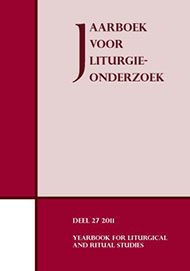Living memory tussen Zivilreligiös herdenken, kunst, healing en attractie. Over de meervoudige identiteit van een Holocaustmonument
Abstract
This contribution takes the Holocaust Memorial in Berlin as its starting point for exploring the identity of memorial places and practices. We will be looking at the complexity and multilayered character of such places and the ritual practices and representations connected with them. A plurality of identities exists. After describing it, its origin and current presentation (2), the Berlin monument is first ‘read’ from the perspective of theory formation on memorial culture and, in particular, from the perspective of living memory (3). Then the tool of sacral-ritual fields is used as a lens to view the monument’s layered character and complexity, and thus its multiple identity (4, 5). First, the fields of religion, healing, commemoration, culture, and leisure are presented. Second, we look at the fields of moral space and ex officio rites and places that usually are seen as falling under civil religion. After a few applications of these fields, that show how one can work with them as a heuristic tool, we finally (6) explore the dynamically layered living memory (Eisenman) that makes it for the monument possible to an open hermeneutic space or hull, and more particularly a place that makes it possible to transfer emotions (Nico Frijda).


